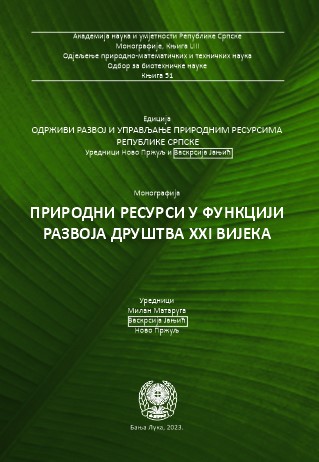Organic agriculture in the function of sustainable development of rural areas of the Republic of Srpska
DOI:
https://doi.org/10.7251/EORU2307371PKeywords:
Organic agriculture, organic agricultural land, principles of organic agriculture, sustainable agriculture, environment, biodiversity, safe food, renewable resources, multifunctional agricultureAbstract
The main task of agriculture is the production of quality and safe food. In conventional agriculture, the use of synthetic plant protection and plant nutrition products is often excessive, uncontrolled and unprofessional, which endangers the production of safe food, its quality and the human and animal health. Conventional agriculture has a negative effect on the environment, primarily on soil, water, air, and biodiversity. In response to the negative effects caused by conventional production, organic agriculture and organic food production emerged. Organic production is a complex production method that must respect strict legal norms and standards. It is a system of sustainable agriculture based on ethical respect of ecological principles through the rational use of natural resources, the use of renewable energy sources, the preservation of natural diversity and environmental protection. Agricultural production is based on the use of inputs obtained on the farm and the application of those methods that lead to the ecological balance of natural systems. Total area of organic agricultural land (OAL) in the world, including areas in conversion, amounted to 71.5 million ha in 2018. Non-agricultural organic land (NAL) (pastures, land for collecting wild plants, areas for beekeeping, aquaculture, and forests) amounted to 35.7 million ha. Over 2/3 of the OAL (more than 48.2 million ha) are grasslands/pastures. OAL in the type of arable land covered 13.3 million ha, which is 18.6% of OAL. Permanent cropland occupied over 4.7 million ha of OAL. Half of the world's OAL in 2018 was in Oceania (36 million ha), followed by Europe (15.6 million ha), Latin America (8 million ha), Asia (6.5 million ha), North America (3.3 million ha) and Africa (2 million ha). The largest areas of organic arable land were located in Europe, followed by Asia and North America. Cereals, including rice (4.8 million ha), fodder legumes (3.9 million ha) and oilseeds were mostly cultivated on arable land in organic production. The largest areas of permanent cropland in organic production are in Europe, followed by Africa and Latin America. The most important permanent crops are olives, coffee, stone fruits, vines, tropical and subtropical fruits, coconut and cocoa. Almost 2.6 million organic hives were registered, which represents 2.6% of the total number of hivesin 2018. The largest number of organic hives is found in Europe and Latin America. Organic aquaculture is mainly concentrated in Europe (56%), Asia (44%) and somewhat less in Latin America. At least 2.8 million organic producers were registered worldwide in 2018 (India 1,149,371, Uganda 210,352, Ethiopia 203,602). In Europe, 418,000 producers managed 15.6 million ha of organic agricultural land, of which 327,000 producers and 13.8 million ha were in the EU. In Europe, 3.1% of agricultural land is in the organic system, while in EU accounts to 7.5%. The countries with the largest areas of OAL were Spain (2.2 million ha), France (2 million ha) and Italy (2 million ha). In ten countries, the area of OAL in relation to the total agriculture is over 10% (Liechtenstein 38.5%, Austria 34.7%, Estonia 21.6%, etc.). The value of sale of organic food and beverages in 2018 amounted to over 97 billion euros, with the largest share of sales in the United States (40.6 billion euros), Germany (10.9 billion), France (9.1 billion) and China (8, 1 billion) The highest consumption of organic food per capita was in Switzerland and Denmark; 312 euros. The largest share of organic food and beverages was in the markets of Denmark (11.5%), Switzerland (9.9%) and Sweden (9.6%). In the production of organic food, Republic of Srpska and Bosnia and Herzegovina, with fragmented plots, have all the conditions for organic production. Organic food production can be a way out for small farmers who cannot be commercially viable in conventional production. Republic of Srpska has a comparative advantage over other countries in Europe due to the preserved agrosystem and unpolluted soil, water and air. The possibility of expanding the volume of organic production in Republic of Srpska also lies in the demand for organic products in larger city centres and the increased interest of domestic consumers in recognisable organic products. Organic production covered 896 ha in Bosnia and Herzegovina in 2018, of which 350 ha were in conversion. Cereals occupied 118 ha, oilseeds 23 ha, vegetables 11 ha, legumes 1 ha, continental fruits 2 ha, and perennial crops 150 ha. The total area of 896 ha represents about 0.03% of the total arable land. Non-agricultural land included 165,534 ha. The term multifunctional agriculture is related to non-marketable functions, and the requirement to achieve sustainable economic, social and ecological development of the environments in which agricultural production takes place. This means that agriculture, in addition to production for the market, should also participate in the development of rural areas, the improvement of the living conditions of its population and the protection and improvement of the environment. Multifunctional agriculture implies a farming type of production, where the emphasis is on the formation of the “eco-farms“. Agri-forestry systems, developed within organic agriculture, increase the complexity of agroecosystems, which represents an increase in the multifunctionality of organic agriculture. This is the reason why organic forestry farms are being developed today, where the interdependence of multifunctional organic agriculture and biodiversity is most clearly visible.
